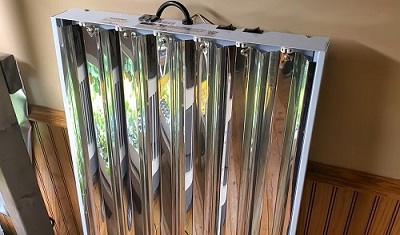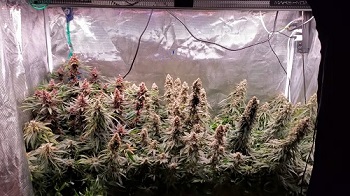Hydroponics is a method of growing plants without soil, where the plants are grown in a nutrient-rich water solution.
This allows for precise control over the growing conditions, including the levels of nutrients, pH, temperature, and humidity. CO2 is an essential element in the process of photosynthesis, where plants convert CO2 and light into energy and oxygen. In a hydroponic system, the levels of CO2 need to be carefully managed to ensure optimal plant growth.
Hydroponic CO2 Calculator
| Information/Feature | Description |
|---|---|
| Purpose | Helps in optimizing CO2 levels for indoor gardens in hydroponic systems |
| Benefits | Provides precise recommendations, saves time and costs, increases efficiency, offers flexibility, minimizes guesswork |
| Factors considered | Size of growing space, type of lighting, number of plants, growth stage, target CO2 levels, environmental conditions, calibration of equipment |
| Usage | Input relevant data such as size of growing space, type of lighting, number of plants, growth stage, and target CO2 levels |
| Output | Provides recommendations on the optimal CO2 levels to maintain for healthy plant growth |
| Monitoring and Adjustments | Regular monitoring of plant performance and adjustments to CO2 levels as needed based on recommendations |
| Calibration | Ensuring proper calibration of CO2 supplementation equipment for accurate results |
| Importance | Helps in achieving optimal plant growth and higher yields in hydroponic systems |
| Time-saving | Provides quick and accurate recommendations, saving time and effort in determining CO2 levels |
| Cost-effective | Avoids unnecessary CO2 supplementation, saving costs on excessive use |
| Flexibility | Allows for adjustments based on changing environmental conditions and plant requirements |
| Minimizes guesswork | Provides precise recommendations, eliminating guesswork in CO2 supplementation |
| Easy to use | User-friendly interface, requiring input of relevant data for accurate results |
| Recommended frequency | Regular usage for monitoring and maintaining optimal CO2 levels for plants |
| Additional resources | Online tutorials, guides, and manufacturer’s instructions for proper usage and calibration |
One of our articles –Hydroponic Lighting Calculator.
Importance of CO2 in hydroponics

CO2 plays a crucial role in the growth and development of plants in hydroponic systems. Higher levels of CO2 can significantly enhance photosynthesis, leading to increased plant growth, improved yields, and faster flowering. CO2 supplementation can also help to overcome limitations in outdoor gardening, such as lower light levels during winter months or in shaded areas. In addition, CO2 can boost the overall health and vitality of plants, making them more resistant to pests and diseases.
Understanding CO2 levels in hydroponics
To optimize the CO2 levels in your hydroponic system, it’s important to understand the factors that affect CO2 availability. Factors such as the size of your growing space, the number of plants, the type of lighting used, and the ventilation system can all impact the levels of CO2 in the air. Monitoring and managing these factors can help you maintain the ideal CO2 levels for your plants’ growth.
Need for a hydroponic CO2 calculator
With the complexity of factors that affect CO2 levels in hydroponic systems, it can be challenging to determine the optimal CO2 levels for your specific setup. This is where a hydroponic CO2 calculator can be a valuable tool. A hydroponic CO2 calculator uses algorithms and data inputs to calculate the ideal CO2 levels based on the specific parameters of your indoor garden. It takes into account factors such as the size of the growing space, the type of lighting, and the number of plants to provide precise recommendations for CO2 supplementation.
One of our articles –Hydroponic EC Calculator.
Benefits of using a hydroponic CO2 calculator
Using a hydroponic CO2 calculator can have several benefits for hydroponic gardeners. Firstly, it can help you optimize the growth and yield of your plants by providing accurate recommendations for CO2 supplementation. This can result in faster growth, improved flowering, and higher overall plant health. Secondly, a hydroponic CO2 calculator can help you save time.
- Precision: A hydroponic CO2 calculator takes into account various parameters of your indoor garden, such as the size of the growing space, the type of lighting, and the number of plants, to provide accurate recommendations for CO2 supplementation. This ensures that you are providing the optimal CO2 levels for your plants, leading to improved growth and yields.
- Time-saving: Determining the ideal CO2 levels for your hydroponic system can be time-consuming and complicated. A hydroponic CO2 calculator simplifies this process by automating the calculations based on the inputs you provide. This saves you time and effort in manually calculating and adjusting CO2 levels.
- Cost-effective: Overdosing or underdosing CO2 in your hydroponic system can lead to wasted resources and decreased yields. By using a hydroponic CO2 calculator, you can avoid unnecessary CO2 supplementation, which can save you money on CO2 cylinders or other CO2 sources.
- Increased Efficiency: Optimizing CO2 levels in your hydroponic system can result in more efficient photosynthesis, leading to improved plant growth and faster flowering. This can help you achieve higher yields and maximize the productivity of your indoor garden.
- Flexibility: A hydroponic CO2 calculator allows you to input different parameters and experiment with various scenarios to find the ideal CO2 levels for your specific setup. This gives you the flexibility to adjust and optimize CO2 levels based on the changing needs of your plants throughout different growth stages or environmental conditions.
- Minimized Guesswork: Without a hydroponic CO2 calculator, it can be challenging to determine the right amount of CO2 to supplement to your indoor garden. Guessing or estimating CO2 levels can lead to inconsistent results and potential harm to your plants. A hydroponic CO2 calculator eliminates the guesswork and provides data-driven recommendations for precise CO2 supplementation.
One of our articles –Hydroponic pH Calculator.
How to use a hydroponic CO2 calculator
Hydroponic CO2 Calculator
CO2 Required: ppm
Using a hydroponic CO2 calculator is simple and straightforward. Here are the steps to effectively use a hydroponic CO2 calculator in your indoor garden:
- Gather data: Collect the necessary information about your indoor garden, such as the size of the growing space, the type of lighting, the number of plants, and the current CO2 levels (if available).
- Choose a reliable calculator: There are several hydroponic CO2 calculators available online, so make sure to choose a reputable and reliable one. Look for calculators that take into account multiple parameters and have positive reviews from other hydroponic gardeners.
- Input data: Enter the data you gathered into the calculator, including the size of the growing space, the type of lighting, and the number of plants. Some calculators may also ask for additional information, such as the target CO2 levels or the growth stage of your plants.
- Review recommendations: Once you have input all the necessary data, the hydroponic CO2 calculator will provide recommendations for the ideal CO2 supplementation levels for your indoor garden. Review the recommendations and make adjustments as needed.
- Monitor and adjust: After implementing the recommended CO2 levels, monitor the performance of your plants and observe their response. Keep track of any changes in growth or yields and adjust the CO2 levels accordingly to optimize the results.
- Regularly recalculate: It’s important to regularly recalculate the CO2 levels using the hydroponic CO2 calculator, especially if there are changes in your indoor garden setup, such as adding more plants or changing the lighting. Regular recalibration ensures that you are providing the optimal CO2 levels for your plants at all times.
Factors to consider when using a hydroponic CO2 calculator
When using a hydroponic CO2 calculator, it’s important to take into consideration several factors to ensure accurate and effective results. Here are some factors to keep in mind:
- Size of growing space: The size of your indoor garden plays a crucial role in determining the optimal CO2 levels. Larger spaces may require higher CO2 supplementation, while smaller spaces may need lower levels. Make sure to accurately measure and input the size of your growing space into the calculator.
- Type of lighting: Different types of lighting, such as LED, HID, or fluorescent, can affect the CO2 requirements of your plants. Some lighting systems may produce more heat, which can impact the CO2 levels. Be sure to specify the type of lighting you are using in your hydroponic system when using the calculator.
- Number of plants: The number of plants in your indoor garden also affects the CO2 levels. More plants may require higher CO2 supplementation to meet their needs. It’s essential to input the correct number of plants into the calculator to get accurate recommendations.
- Growth stage of plants: The growth stage of your plants, whether it’s the vegetative or flowering stage, can also impact the CO2 levels. Different stages may require different CO2 levels for optimal growth. Make sure to specify the growth stage of your plants in the calculator to get appropriate recommendations.
- Target CO2 levels: The target CO2 levels for your indoor garden may vary depending on the type of plants you are growing and the environmental conditions. Some plants may thrive at higher CO2 levels, while others may require lower levels. Consider the specific requirements of your plants and input the target CO2 levels accordingly.
- Environmental conditions: The environmental conditions in your indoor garden, such as temperature and humidity, can also affect the CO2 requirements of your plants. Warmer temperatures may require higher CO2 levels, while higher humidity may impact the CO2 uptake. Take into account the current environmental conditions when using the CO2 calculator for accurate results.
- Calibration of equipment: If you are using CO2 supplementation equipment, such as a CO2 generator or regulator, it’s essential to calibrate them regularly. Accurate calibration ensures that you are providing the right amount of CO2 as per the recommendations of the calculator. Make sure to follow the manufacturer’s instructions for calibration and input the correct values into the calculator.
- Monitoring and adjustments: It’s crucial to regularly monitor the performance of your plants and observe their response to the recommended CO2 levels. If you notice any changes in growth or yields, make adjustments to the CO2 levels as needed. Regular monitoring and adjustments ensure that you are maintaining optimal CO2 levels for your plants.
By considering these factors and using a hydroponic CO2 calculator as a tool, you can effectively optimize CO2 levels in your indoor garden and promote healthy plant growth and high yields.
One of our articles –Indoor Garden Calculator.
Conclusion
In conclusion, using a hydroponic CO2 calculator can provide numerous benefits in optimizing CO2 levels for your indoor garden. It helps in achieving precision, saves time and costs, increases efficiency, provides flexibility, and minimizes guesswork.
However, it’s essential to consider various factors such as the size of the growing space, type of lighting, number of plants, growth stage, target CO2 levels, environmental conditions, and calibration of equipment for accurate results.
Regular monitoring and adjustments based on the recommendations of the calculator are crucial to maintain optimal CO2 levels for your plants. By utilizing a hydroponic CO2 calculator effectively, you can enhance the performance of your indoor garden and achieve healthy plant growth and higher yields.




